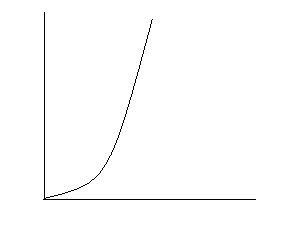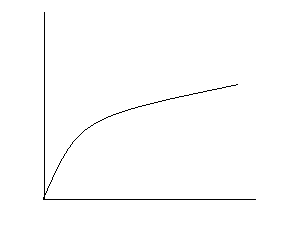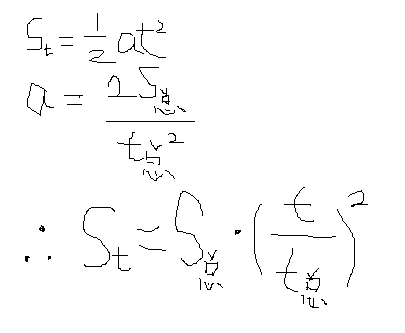WPF与缓动(一) N次缓动
WPF与缓动(一) N次缓动
周银辉
如果我们希望制作的动画效果像现实生活中的运动一样平滑, 比如汽车的启动与停止总有一个加速或减速的过程, 那么我们有必要研究一下"缓动"
缓入: 速度逐渐增加的过程,比如汽车的启动
如果我们用曲线上的点的斜率表示速度,那么在数学上它对应了下面这样的曲线:

缓出:速度逐渐减小的过程,比如汽车的停止
在数学上它对应了下面的曲线

就加速运动而言, 根据以下位置与加速度等公式

我们可以得到,任意时刻的速度等于总的路程乘以当前时间与总时间的比值的平方, 而总的路程实际将相当与WPF中Animation的To与From的差值, 当前时间与总时间的比值实际上相当与WPF中animationClock.CurrentProgress.Value值.
除此之外,我们发现,曲线的指数越大,点的斜率变化越快,那么加速度也就越大.
有了这些知识,我们可以很好的模拟加速运动了
参考以下代码
 using System;
using System;
 using System.Collections.Generic;
using System.Collections.Generic;
 using System.Text;
using System.Text;
 using System.Windows.Media.Animation;
using System.Windows.Media.Animation;
 using System.Windows;
using System.Windows;

 namespace EaseMoveDemo
namespace EaseMoveDemo
 {
{
 public class EaseMoveAnimation : DoubleAnimationBase
public class EaseMoveAnimation : DoubleAnimationBase
 {
{

 public static readonly DependencyProperty FromProperty = DependencyProperty.Register(
public static readonly DependencyProperty FromProperty = DependencyProperty.Register(
 "From", typeof(double?), typeof(EaseMoveAnimation), new PropertyMetadata(null));
"From", typeof(double?), typeof(EaseMoveAnimation), new PropertyMetadata(null));

 public static readonly DependencyProperty ToProperty = DependencyProperty.Register(
public static readonly DependencyProperty ToProperty = DependencyProperty.Register(
 "To", typeof(double?), typeof(EaseMoveAnimation), new PropertyMetadata(null));
"To", typeof(double?), typeof(EaseMoveAnimation), new PropertyMetadata(null));

 public static readonly DependencyProperty PowerProperty = DependencyProperty.Register(
public static readonly DependencyProperty PowerProperty = DependencyProperty.Register(
 "Power", typeof(double?), typeof(EaseMoveAnimation), new PropertyMetadata(null));
"Power", typeof(double?), typeof(EaseMoveAnimation), new PropertyMetadata(null));

 public double? From
public double? From
 {
{
 get
get
 {
{
 return (double?)this.GetValue(EaseMoveAnimation.FromProperty);
return (double?)this.GetValue(EaseMoveAnimation.FromProperty);
 }
}
 set
set
 {
{
 this.SetValue(EaseMoveAnimation.FromProperty, value);
this.SetValue(EaseMoveAnimation.FromProperty, value);
 }
}
 }
}

 public double? To
public double? To
 {
{
 get
get
 {
{
 return (double?)this.GetValue(EaseMoveAnimation.ToProperty);
return (double?)this.GetValue(EaseMoveAnimation.ToProperty);
 }
}
 set
set
 {
{
 this.SetValue(EaseMoveAnimation.ToProperty, value);
this.SetValue(EaseMoveAnimation.ToProperty, value);
 }
}
 }
}

 /// <summary>
/// <summary>
 /// 幂指数,值越大,曲线上点的斜率越大,加速度越大,设置为5时效果较好
/// 幂指数,值越大,曲线上点的斜率越大,加速度越大,设置为5时效果较好
 /// </summary>
/// </summary>
 public double? Power
public double? Power
 {
{
 get
get
 {
{
 return (double?)this.GetValue(EaseMoveAnimation.PowerProperty);
return (double?)this.GetValue(EaseMoveAnimation.PowerProperty);
 }
}
 set
set
 {
{
 this.SetValue(EaseMoveAnimation.PowerProperty, value);
this.SetValue(EaseMoveAnimation.PowerProperty, value);
 }
}
 }
}

 protected override double GetCurrentValueCore(double defaultOriginValue, double defaultDestinationValue, AnimationClock animationClock)
protected override double GetCurrentValueCore(double defaultOriginValue, double defaultDestinationValue, AnimationClock animationClock)
 {
{
 double from = (this.From==null?defaultDestinationValue:(double)this.From);
double from = (this.From==null?defaultDestinationValue:(double)this.From);
 double to = (this.To==null?defaultOriginValue:(double)this.To);
double to = (this.To==null?defaultOriginValue:(double)this.To);
 double delta = to - from;
double delta = to - from;
 double power = this.Power == null ? 2 : (double)this.Power;
double power = this.Power == null ? 2 : (double)this.Power;

 //加速
//加速
 return delta * Math.Pow(animationClock.CurrentProgress.Value, power) + from;
return delta * Math.Pow(animationClock.CurrentProgress.Value, power) + from;
 //return delta * Math.Pow(animationClock.CurrentProgress.Value, 1/power) + from;
//return delta * Math.Pow(animationClock.CurrentProgress.Value, 1/power) + from;

 //先加速后减速
//先加速后减速
 //if (animationClock.CurrentProgress.Value < 0.5)
//if (animationClock.CurrentProgress.Value < 0.5)
 //{
//{
 // return delta / 2 * Math.Pow(animationClock.CurrentProgress.Value * 2, power) + from;
// return delta / 2 * Math.Pow(animationClock.CurrentProgress.Value * 2, power) + from;
 //}
//}
 //return delta / 2 * Math.Pow((animationClock.CurrentProgress.Value - 0.5) * 2, 1/power) + delta / 2 + from;
//return delta / 2 * Math.Pow((animationClock.CurrentProgress.Value - 0.5) * 2, 1/power) + delta / 2 + from;
 }
}


 protected override System.Windows.Freezable CreateInstanceCore()
protected override System.Windows.Freezable CreateInstanceCore()
 {
{
 return new EaseMoveAnimation();
return new EaseMoveAnimation();
 }
}
 }
}
 }
}

周银辉
如果我们希望制作的动画效果像现实生活中的运动一样平滑, 比如汽车的启动与停止总有一个加速或减速的过程, 那么我们有必要研究一下"缓动"
缓入: 速度逐渐增加的过程,比如汽车的启动
如果我们用曲线上的点的斜率表示速度,那么在数学上它对应了下面这样的曲线:

缓出:速度逐渐减小的过程,比如汽车的停止
在数学上它对应了下面的曲线

就加速运动而言, 根据以下位置与加速度等公式

我们可以得到,任意时刻的速度等于总的路程乘以当前时间与总时间的比值的平方, 而总的路程实际将相当与WPF中Animation的To与From的差值, 当前时间与总时间的比值实际上相当与WPF中animationClock.CurrentProgress.Value值.
除此之外,我们发现,曲线的指数越大,点的斜率变化越快,那么加速度也就越大.
有了这些知识,我们可以很好的模拟加速运动了
参考以下代码
 using System;
using System; using System.Collections.Generic;
using System.Collections.Generic; using System.Text;
using System.Text; using System.Windows.Media.Animation;
using System.Windows.Media.Animation; using System.Windows;
using System.Windows;
 namespace EaseMoveDemo
namespace EaseMoveDemo {
{ public class EaseMoveAnimation : DoubleAnimationBase
public class EaseMoveAnimation : DoubleAnimationBase {
{
 public static readonly DependencyProperty FromProperty = DependencyProperty.Register(
public static readonly DependencyProperty FromProperty = DependencyProperty.Register( "From", typeof(double?), typeof(EaseMoveAnimation), new PropertyMetadata(null));
"From", typeof(double?), typeof(EaseMoveAnimation), new PropertyMetadata(null));
 public static readonly DependencyProperty ToProperty = DependencyProperty.Register(
public static readonly DependencyProperty ToProperty = DependencyProperty.Register( "To", typeof(double?), typeof(EaseMoveAnimation), new PropertyMetadata(null));
"To", typeof(double?), typeof(EaseMoveAnimation), new PropertyMetadata(null));
 public static readonly DependencyProperty PowerProperty = DependencyProperty.Register(
public static readonly DependencyProperty PowerProperty = DependencyProperty.Register( "Power", typeof(double?), typeof(EaseMoveAnimation), new PropertyMetadata(null));
"Power", typeof(double?), typeof(EaseMoveAnimation), new PropertyMetadata(null));
 public double? From
public double? From {
{ get
get {
{ return (double?)this.GetValue(EaseMoveAnimation.FromProperty);
return (double?)this.GetValue(EaseMoveAnimation.FromProperty); }
} set
set {
{ this.SetValue(EaseMoveAnimation.FromProperty, value);
this.SetValue(EaseMoveAnimation.FromProperty, value); }
} }
}
 public double? To
public double? To {
{ get
get {
{ return (double?)this.GetValue(EaseMoveAnimation.ToProperty);
return (double?)this.GetValue(EaseMoveAnimation.ToProperty); }
} set
set {
{ this.SetValue(EaseMoveAnimation.ToProperty, value);
this.SetValue(EaseMoveAnimation.ToProperty, value); }
} }
}
 /// <summary>
/// <summary> /// 幂指数,值越大,曲线上点的斜率越大,加速度越大,设置为5时效果较好
/// 幂指数,值越大,曲线上点的斜率越大,加速度越大,设置为5时效果较好 /// </summary>
/// </summary> public double? Power
public double? Power {
{ get
get {
{ return (double?)this.GetValue(EaseMoveAnimation.PowerProperty);
return (double?)this.GetValue(EaseMoveAnimation.PowerProperty); }
} set
set {
{ this.SetValue(EaseMoveAnimation.PowerProperty, value);
this.SetValue(EaseMoveAnimation.PowerProperty, value); }
} }
}
 protected override double GetCurrentValueCore(double defaultOriginValue, double defaultDestinationValue, AnimationClock animationClock)
protected override double GetCurrentValueCore(double defaultOriginValue, double defaultDestinationValue, AnimationClock animationClock) {
{ double from = (this.From==null?defaultDestinationValue:(double)this.From);
double from = (this.From==null?defaultDestinationValue:(double)this.From); double to = (this.To==null?defaultOriginValue:(double)this.To);
double to = (this.To==null?defaultOriginValue:(double)this.To); double delta = to - from;
double delta = to - from; double power = this.Power == null ? 2 : (double)this.Power;
double power = this.Power == null ? 2 : (double)this.Power;
 //加速
//加速 return delta * Math.Pow(animationClock.CurrentProgress.Value, power) + from;
return delta * Math.Pow(animationClock.CurrentProgress.Value, power) + from; //return delta * Math.Pow(animationClock.CurrentProgress.Value, 1/power) + from;
//return delta * Math.Pow(animationClock.CurrentProgress.Value, 1/power) + from;
 //先加速后减速
//先加速后减速 //if (animationClock.CurrentProgress.Value < 0.5)
//if (animationClock.CurrentProgress.Value < 0.5) //{
//{ // return delta / 2 * Math.Pow(animationClock.CurrentProgress.Value * 2, power) + from;
// return delta / 2 * Math.Pow(animationClock.CurrentProgress.Value * 2, power) + from; //}
//} //return delta / 2 * Math.Pow((animationClock.CurrentProgress.Value - 0.5) * 2, 1/power) + delta / 2 + from;
//return delta / 2 * Math.Pow((animationClock.CurrentProgress.Value - 0.5) * 2, 1/power) + delta / 2 + from; }
}

 protected override System.Windows.Freezable CreateInstanceCore()
protected override System.Windows.Freezable CreateInstanceCore() {
{ return new EaseMoveAnimation();
return new EaseMoveAnimation(); }
} }
} }
}







 浙公网安备 33010602011771号
浙公网安备 33010602011771号